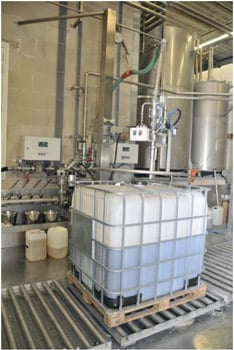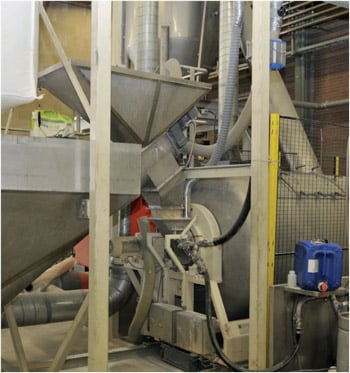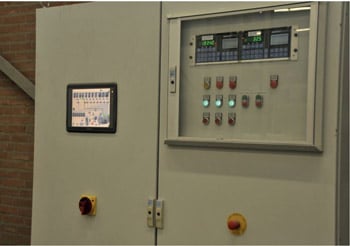 Daavision, a manufacturing company in Oss, the Netherlands, specializes on producing natural based additives for animal feed. These stable additives are manufactured on the basis of organic acids. A key objective for Daavision is to improve the welfare of animals, inter alia, by the reduction of mortality among piglets, the reduction of the use of medication such as antibiotics as well as the improvement and stimulation of the immune system of young cattle. All products are developed in-house and are manufactured using their own means of production.
Daavision, a manufacturing company in Oss, the Netherlands, specializes on producing natural based additives for animal feed. These stable additives are manufactured on the basis of organic acids. A key objective for Daavision is to improve the welfare of animals, inter alia, by the reduction of mortality among piglets, the reduction of the use of medication such as antibiotics as well as the improvement and stimulation of the immune system of young cattle. All products are developed in-house and are manufactured using their own means of production.
Such additives are required to meet the highest standards. Quality must be reliable and constant. Furthermore, they are part of the food chain where traceability, tracking & tracing is essential. Traceability at Daavision is provided twofold. Firstly in connection with a possible recall of a particular product and/or of a specific raw material component with a traceability of the related supplier. Secondly, a number of variables are fixed per finished product, such as:
- type of raw material used
- the analysis data per raw material at material receipt
- under which material number the counter sample of the raw material is saved
- the supplier of the raw material
The process
 Daavision uses three semi combined processes. In the first instance it is a wet environment for the dosing and mixing of fluids. This is done in a fluid mixer. There are four variations for this wet section:
Daavision uses three semi combined processes. In the first instance it is a wet environment for the dosing and mixing of fluids. This is done in a fluid mixer. There are four variations for this wet section:
- Acids only; in this simple process all acid components are dosed and mixed based on weight and transported to an interim storage container.
- Acids and powders; first the powders are dosed on weight weighed manually and placed in the powder hopper. The acid then gets added to this as described under point 1. While the acid mixture is blended, the powder hopper simultaneously releases its contents into the acid concoction. Subsequently an additional blending cycle takes place after which the mixture is pumped to an interim storage.
- Acids and water ammonia solution; during this process, the acid is dosed as described under point 1. The cooling tower gets activated and blends the mixture. During this process the dosing of the ammonia solution is added based on weight. During this phase it is essential to closely monitor the temperature. Should the temperature increase over a specified set value, the system will automatically stop the dosing of the ammonia until the mixture has cooled down to the set value. This cycle is repeated until the required amount of ammonia has been added. After completion of the blending time, the mixture is transported to an interim storage.
- Acids, powders and ammonia; this process is a combination of the processes 1, 2 and 3.
The second process, which is largely a dry process, consists of spraying an acid blend onto a carrier which is typically a powder (? yes). First the powder is dosed from a big bag into an interim intermediate (?) hopper and from there by means of a screw conveyor into the powder mixer. Once this is ready, the mixer is activated and the active fluids are spayed onto the powder. Subsequently the mixer will continue to run for a set period of time after which the product is ready for storage in a buffer tank.
The third process is formed by the hoppers containing the semi-ready products and which includes two gross filling fluid fillers for filling cans of 10 or 25kg, drums of 225kg and similar to IBC’s as well as for big bags. In addition there is a fully automated bagging line with a robot stapler and finally, the fluid product is also delivered in bulk.
The suppliers
Daavision deliberately chose to conduct their dosing processes based on weighing raw material components for fluids as well as solids. After all, weighing indeed remains chemically correct. Every molecule has its own intrinsic weight which is independent of temperature, pressure, air insertion and/or foaming. Therefore, when dosing on weight, it is evident that the relationship between the various components is correct. This saves calculation work, prevents thinking and rounding errors which benefits regards to accuracy and reliability of the process flow. An additional advantage is that both the wet and the dry phases have a comparable measuring system.
Daavision proposed a comprehensive set of requirements for the supplier of measurement and control systems. Obviously, the accuracy and reliability played a major role. But, there is indeed a good deal of process automation involved as well as the knowledge and experience with automation systems. Furthermore the means of production must consistently be reliable. Animals must eat on a daily basis and a good maintenance service which can keep the system up to date and calibrate is, just as essential. The GMP+ certificate and the recognition by the nVWA are a requirement to Daavision. All of these requirements are satisfied by PENKO Engineering. Both parties quickly agreed that when goods are produced from dependable raw materials, there is no need for any returns. An additional decisive factor was that PENKO is able to deliver the entire controlling system including the motor switchgear as well as cabinet building.
The flexibility of PENKO, centralization of what needs to be centralized and decentralization what can be decentralized, added to the problem free and flexible process flow.
Service and maintenance are adequately guaranteed, after all, PENKO is not only accredited by the NMI (Nederlands Meetinstituut, the Dutch Weighing Society), but also closely works with Verispect, the inspectorate body of the Dutch central government for metrological legislation.
The systems
 For the central system PENKO supplied their inhouse developed BCS-system based on a personal computer. The entire recipe database for Daavision is stored in this system. The recipes contain the various components, including fluids and powders, ratios and granulation formation in percentages. The manufacturing operator uses these recipes to formulate the desired number of production batches defined by weight per batch. The system converts the percentages into weight and sends the production order/s to the weighing controller. This goes for all raw materials as well as fluids. Each of the raw materials/fluids is weighed. Furthermore the system monitors the component stock levels. In connection with the traceability of each component, a lot number is stored. Once the batch recipe is ready, the start and end time of the production process is defined, the weight, component names, lot numbers and similar data including any additional information such as pH-value, is saved to a central database. Stainless steel sensors which are hermetically sealed, similar to those used in the pharmaceutical or food processing industry, are used. The mounting accessories are equally made of stainless steel. The proven concept of PENKO is used to control the process whereby individually functioning controllers, connected via a data-port, can, where required, be used as one single system. Thanks to this method, the information required for tracking & tracing, is effortlessly followed through each production phase. Due to the fast weighing speed and high internal resolution, PENKO also proves its value throughout this process.
For the central system PENKO supplied their inhouse developed BCS-system based on a personal computer. The entire recipe database for Daavision is stored in this system. The recipes contain the various components, including fluids and powders, ratios and granulation formation in percentages. The manufacturing operator uses these recipes to formulate the desired number of production batches defined by weight per batch. The system converts the percentages into weight and sends the production order/s to the weighing controller. This goes for all raw materials as well as fluids. Each of the raw materials/fluids is weighed. Furthermore the system monitors the component stock levels. In connection with the traceability of each component, a lot number is stored. Once the batch recipe is ready, the start and end time of the production process is defined, the weight, component names, lot numbers and similar data including any additional information such as pH-value, is saved to a central database. Stainless steel sensors which are hermetically sealed, similar to those used in the pharmaceutical or food processing industry, are used. The mounting accessories are equally made of stainless steel. The proven concept of PENKO is used to control the process whereby individually functioning controllers, connected via a data-port, can, where required, be used as one single system. Thanks to this method, the information required for tracking & tracing, is effortlessly followed through each production phase. Due to the fast weighing speed and high internal resolution, PENKO also proves its value throughout this process.
The dosing is done fast and with the highest accuracy. The powder dosing in the wet phase, is a story on its own.
The weigher or scale where manual dosing is conducted is furnished with an operator terminal which indicates the quantity in weight for the required powder. The operator weighs the powder and manually confirms the process by pressing a button.
